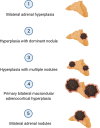Molecular Genetic and Genomic Alterations in Cushing's Syndrome and Primary Aldosteronism
- PMID: 33776926
- PMCID: PMC7994620
- DOI: 10.3389/fendo.2021.632543
Molecular Genetic and Genomic Alterations in Cushing's Syndrome and Primary Aldosteronism
Abstract
The genetic alterations that cause the development of glucocorticoid and/or mineralocorticoid producing benign adrenocortical tumors and hyperplasias have largely been elucidated over the past two decades through advances in genomics. In benign aldosterone-producing adrenocortical tumors and hyperplasias, alteration of intracellular calcium signaling has been found to be significant in aldosterone hypersecretion, with causative defects including those in KCNJ5, ATP1A1, ATP2B3, CACNA1D, CACNA1H, and CLCN2. In benign cortisol-producing adrenocortical tumors and hyperplasias abnormal cyclic adenosine monophosphate-protein kinase A signaling has been found to play a central role in tumorigenesis, with pathogenic variants in GNAS, PRKAR1A, PRKACA, PRKACB, PDE11A, and PDE8B being implicated. The role of this signaling pathway in the development of Cushing's syndrome and adrenocortical tumors was initially discovered through the study of the underlying genetic defects causing the rare multiple endocrine neoplasia syndromes McCune-Albright syndrome and Carney complex with subsequent identification of defects in genes affecting the cyclic adenosine monophosphate-protein kinase A pathway in sporadic tumors. Additionally, germline pathogenic variants in ARMC5, a putative tumor suppressor, were found to be a cause of cortisol-producing primary bilateral macronodular adrenal hyperplasia. This review describes the genetic causes of benign cortisol- and aldosterone-producing adrenocortical tumors.
Keywords: Cushing’s syndrome; adrenocortical adenoma; adrenocortical hyperplasia; genetics; primary aldosteronism.
Copyright © 2021 Kamilaris, Stratakis and Hannah-Shmouni.
Conflict of interest statement
CS holds patents on the PRKAR1A, PDE11A, and GPR101 genes and/or their function and has received research funding from Pfizer Inc. on the genetics and treatment of abnormalities of growth hormone secretion. The remaining authors declare that the research was conducted in the absence of any commercial or financial relationships that could be construed as a potential conflict of interest.
Figures




References
Publication types
MeSH terms
Substances
Grants and funding
LinkOut - more resources
Full Text Sources
Other Literature Sources
Medical
Miscellaneous

